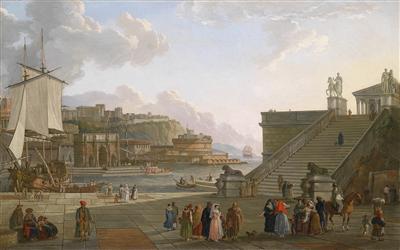Jean Jacques François Taurel

(Toulon 1757–1832 Paris)
A Mediterranean Port with an Architectural Capriccio of Motifs from Roman Antiquity,
signed and dated, lower left: J. Taurel F. 182(7?),
oil on canvas, 65 x 102 cm, framed
Provenance:
South American private collection
The present painting is an important rediscovery that sheds light on French veduta painting. Taurel is considered one of the most outstanding exponents of French landscape and topographical painting, a discipline developed by Claude Joseph Vernet. Other well-known practitioners of this genre were such artists as Charles François de La Croix, called. Lacroix de Marseille, and Carle Vernet. During the Empire period, Taurel was known as one of the most popular artists of naval battles and views of Mediterranean seaports in the manner of Vernet. He exhibited without interruption at the Paris Salon between 1787 and 1817, i.e., from the Ancien Régime to the Bourbon Restoration. In 1700, Taurel painted the Entrance of the French Army in Naples (Château de Versailles) for Napoleon. The present painting goes far beyond an accurately rendered topographical view or a history painting. In its educational ambition, which was in line with the age of the Restoration, the picture’s architectural melange of significant buildings of ancient Rome is combined with an appealingly composed ideal landscape and a southern atmosphere of summer that seems to rely on careful studies of nature. A comparable pair of ideal vedute was sold at Christie’s, London, on 13 Dec. 1996 as lot 72. Elegant strollers, merchants, and deckhands populate the port’s mole. In the background, on the far side of the entrance to the port, appears the Castel Sant’Angelo, while the Arch of Constantine rises on a promontory nearer to the foreground. Such architectural elements represented standard components of the repertoire of capriccio painting, while the remaining buildings would have challenged the classical knowledge of contemporary viewers and reflect the interest in antiquity sparked by archaeological finds made in the second half of the 18th century. In the background appears a palace, probably modelled after the imperial villa on the Palatine Hill in Rome, whereas to the right-hand side of the mole, a fantastic depiction of the Capitoline Hill combines Michelangelo’s stairway and the statues of Castor and Pollux with the Roman Temple of Jupiter, which had originally stood in this place.
Specialist: Dr. Alexander Strasoldo
 Dr. Alexander Strasoldo
Dr. Alexander Strasoldo
+43-1-515 60-556
alexander.strasoldo@dorotheum.at
17.04.2013 - 18:00
- Estimate:
-
EUR 30,000.- to EUR 35,000.-
Jean Jacques François Taurel
(Toulon 1757–1832 Paris)
A Mediterranean Port with an Architectural Capriccio of Motifs from Roman Antiquity,
signed and dated, lower left: J. Taurel F. 182(7?),
oil on canvas, 65 x 102 cm, framed
Provenance:
South American private collection
The present painting is an important rediscovery that sheds light on French veduta painting. Taurel is considered one of the most outstanding exponents of French landscape and topographical painting, a discipline developed by Claude Joseph Vernet. Other well-known practitioners of this genre were such artists as Charles François de La Croix, called. Lacroix de Marseille, and Carle Vernet. During the Empire period, Taurel was known as one of the most popular artists of naval battles and views of Mediterranean seaports in the manner of Vernet. He exhibited without interruption at the Paris Salon between 1787 and 1817, i.e., from the Ancien Régime to the Bourbon Restoration. In 1700, Taurel painted the Entrance of the French Army in Naples (Château de Versailles) for Napoleon. The present painting goes far beyond an accurately rendered topographical view or a history painting. In its educational ambition, which was in line with the age of the Restoration, the picture’s architectural melange of significant buildings of ancient Rome is combined with an appealingly composed ideal landscape and a southern atmosphere of summer that seems to rely on careful studies of nature. A comparable pair of ideal vedute was sold at Christie’s, London, on 13 Dec. 1996 as lot 72. Elegant strollers, merchants, and deckhands populate the port’s mole. In the background, on the far side of the entrance to the port, appears the Castel Sant’Angelo, while the Arch of Constantine rises on a promontory nearer to the foreground. Such architectural elements represented standard components of the repertoire of capriccio painting, while the remaining buildings would have challenged the classical knowledge of contemporary viewers and reflect the interest in antiquity sparked by archaeological finds made in the second half of the 18th century. In the background appears a palace, probably modelled after the imperial villa on the Palatine Hill in Rome, whereas to the right-hand side of the mole, a fantastic depiction of the Capitoline Hill combines Michelangelo’s stairway and the statues of Castor and Pollux with the Roman Temple of Jupiter, which had originally stood in this place.
Specialist: Dr. Alexander Strasoldo
 Dr. Alexander Strasoldo
Dr. Alexander Strasoldo
+43-1-515 60-556
alexander.strasoldo@dorotheum.at
|
Buyers hotline
Mon.-Fri.: 10.00am - 5.00pm
old.masters@dorotheum.at +43 1 515 60 403 |
| Auction: | Old Master Paintings |
| Auction type: | Saleroom auction |
| Date: | 17.04.2013 - 18:00 |
| Location: | Vienna | Palais Dorotheum |
| Exhibition: | 06.04. - 17.04.2013 |
